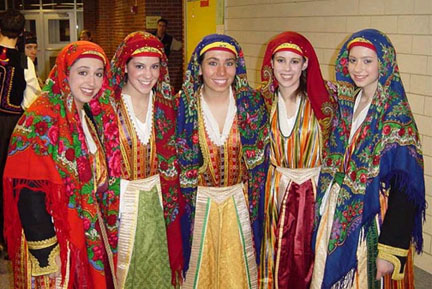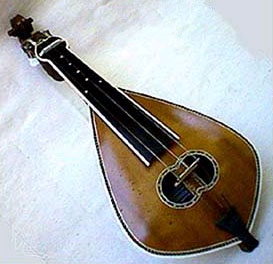| ISLAND DANCE | |||
There are two distinct categories in the traditional Greek dance; the springing/leaping dance
and the shuffle/dragging dance known as Syrtos. The later is the oldest, and most
representative of island dance. Over the years, climatic conditions of the lands and
people's social lives have both influenced and developed the characteristics of traditional
regional Greek dance. Surrounded by the beautiful Mediterranean Sea, island dances are
characterized by the "lightness" of steps while those of the mountainous mainland are
heavier and, at times, at a slow-to-fast pace.
 Most dances are circle like dances, starting with the right foot and moving counter clockwise.
Each dancer is linked by a handkerchief, or by holding hands. In island dances, the circle is
usually formed by groups of families, the husband leading the wife, who would be then followed
by the eldest son, and the rest of the children. Occasionally, the local priest would lead the
way for the first dance, symbolizing a blessing to the family. In olden times, a man would
never hold a womanís hand but a kerchief unless it was his wife. While in other regions a woman
would not be able to dance next to a man that was not part of her family.
Most dances are circle like dances, starting with the right foot and moving counter clockwise.
Each dancer is linked by a handkerchief, or by holding hands. In island dances, the circle is
usually formed by groups of families, the husband leading the wife, who would be then followed
by the eldest son, and the rest of the children. Occasionally, the local priest would lead the
way for the first dance, symbolizing a blessing to the family. In olden times, a man would
never hold a womanís hand but a kerchief unless it was his wife. While in other regions a woman
would not be able to dance next to a man that was not part of her family.
Greece has 6 mainland regions, and 3 island regions. The island categories are the Ionian Islands, to the West, the Aegean Islands (Cyclades and Sporades groups) to the east and the Dodecanese islands to the southwest. The largest of all the islands is Crete. Although Cyprus is an independent country, it is however the largest inhabited island by Greeks, and falls within the Greek major cultural regions. The following descriptions of Greek dances come from the book ìWorld of Greek Danceî, the ìGreek Folk Dance Manualî and a variety of websites as found in our bibliography. Aegean Islands The Aegean Islands can be found between the coasts of Greece and Turkey. Villages of the inhabited islands are clustered with traditional little cubical, whitewashed houses. It is characterized by delightful music that is very lyrical and graceful. As such, the dances exemplify lightness of steps, and the springing in the knees. Most frequently danced are the Ballos, Syrtos, Tata, Savrots, Chiotikos and Ikariotikos. Aegean Dances are joyous and lyrical. Dodecanese Islands Dodecanese means twelve islands. These islands were under Italian rule between 1923 till 1944, and then the British rule from 1944 till 1947. After 24 years of being an occupied territory, the islands were finally reunited with Greece in 1948. The islands have been an occupied territory more than once; hence, the inhabitants of this region were influenced in their dances by their conquerors. These islands have remained isolated by distance and therefore relatively unchanged. Most are barren and the people live from the sea. One of the major influences was the Cretans who immigrated, fleeing from the Turks. The music is characterized by a particular plaintiveness. Dances from this region include, Syrtos, Ballos, Issos, Syrtos Radou and Trata. Ionian Islands Also known as Eptanisia, meaning the seven islands, were reunited with Greece in 1864. These islands were highly influenced by Italy. The people from Corfu are particularly musical. It is not uncommon to see organized concerts in the main square. The dances are graceful and flirtatious. Cephallonians are noted for their humor, which is portrayed in their dances. Most frequent dances are Ai Yiogis, Ballos, Kerkyraikos, Katoa sto Yialo and Tsirgotikos. Cyprus Cyprus is one of the largest Greek islands in the Far East Mediterranean Sea, 60 miles west of Syria and 40 miles south of Turkey. Due to the close proximity of these Arab countries, Cyprus is an island that has been most influenced by Arab music. Hence, their dances are quite distinctive, but still similar to those found on the Aegean Islands.  Here are some of the dances that are more well known and popular throughout the islands of
Greece.
Here are some of the dances that are more well known and popular throughout the islands of
Greece.
Dodecanese Sousta A family of dances on the Dodecanese islands. The name means "spring," describing the hoppy steps. The rhythm is an even 2/4 (one-two, one-two). Each island has its own version and its own songs, with those of Rhodes and Karpathos perhaps being the best known. The remaining Greek villages in Southern Italy do a version of this dance, perhaps because the Dodecanese were also under Italian control until 1947. Island (Nisiotiko) Syrtos/Silyvriano Syrtos The basic dance on the Aegean islands instead of the Kalamatiano. Before the 1922 catastrophe it was also very popular among the Greeks of Constantinople and western Asia Minor (Ionia). It has a lilt different from any of the other Syrtos. Like the related Ballos, it may be danced in either 2/4 or 8/8 time. The alternative name, Silyvriano, is from the most famous song for the dance, which comes from Silyvria, just south of Constantinople on the Sea of Marmara. Several other famous Syrtos songs are named after their places of origin: Politiko. Sometimes the Syrtos is part of other dances; for example, in Mihanikos from Kalymnos, slower music interrupts the Syrtos and the leader dances with a cane, imitating back problems, which are common to the sponge-divers of the island. Ballos Italians occupying the Greek islands named Ballos after a similar dance of their own, but their name originally comes from Greek; the verb "ballizo", which meant "to dance alone" in ancient Greek. The basic "promenade" step is almost identical to the island Syrtos (see above), except that it is done by couples rather than in a circle. Often the island Syrtos is danced first, and then the couples break off from the circle into the Ballos without stopping. Beyond the basic step, the steps are largely improvised by the couples. Ballos may be danced either in 2/4 time or 8/8 time. The dance is known throughout the Greek islands including Cyprus, and before the 1922 catastrophe it was also popular among the Greeks of Constantinople and western Asia Minor (Ionia). | |||
| See Thracian | See Pontian |
Back to Performance |
Back to Main |